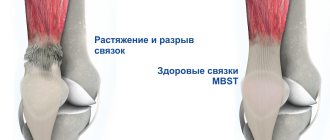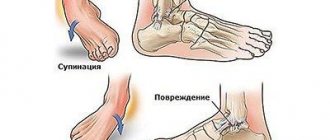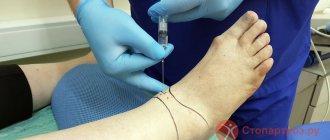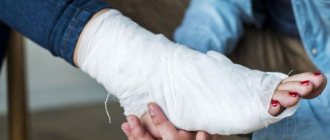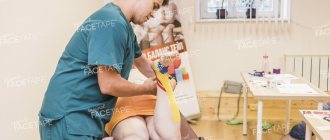The lower extremities of a person are subject to frequent mechanical stress, so it is not surprising that many patients complain of ankle ligament injuries. Up to 12% of cases of damage to this joint occur due to tears and sprains. This problem is especially relevant for athletes, but no less often people with injuries after falls on a slippery plane go to emergency rooms. Clinical manifestations are individual, their intensity is determined by the severity of the injury and the presence of accompanying disorders. Patients complain of pain, stiffness in limb movement, and swelling. Therapeutic effects include physical therapy, leg immobilization, massage procedures, and the prescription of painkillers and anti-inflammatory drugs.
The ArthroMedCenter Joint and Spine Clinic has been treating sports injuries of various types for many years. The Center’s specialists offer effective treatment for damaged tissue - MBST therapy.
Principles of treatment of ankle ligament injuries
Damage to the ankle ligaments and a diagnosis of sprain or rupture can only be determined after examination by an orthopedist. For these purposes, a visual examination, palpation of the area, examination of an x-ray, and, if necessary, an MRI are carried out. Treatment of ankle ligament injuries can be carried out on an outpatient basis or in a hospital. As a rule, joint immobilization methods or surgical restoration are used.
Mild stage ligamentous deformities require stabilization with special bandages. The position of the fibers is fixed with a tight bandage. Doctors may prescribe anti-inflammatory drugs, as well as medications to stimulate blood flow in the leg area.
Treatment of damage to the ligaments of the ankle joint in cases of moderate injuries is usually carried out in combination with the prescription of painkillers, by applying a bandage to ensure the strength of the attachment of the fibers to each other. During the first period, rest is required, and you can move on to therapeutic exercises on an individual basis only 14 days after the injury.
The standard therapeutic process requires the use of a bandage or plaster cast, as well as restorative procedures. As a result, complete stabilization of the ankle joint can be achieved in 8-9 weeks. If conservative treatment of ankle ligament damage is not sufficiently effective, then surgical intervention is prescribed, for example, invasive reconstructive surgery is performed. If the ligaments are completely torn when surgery was performed, the rehabilitation period lasts several months.
Conservative treatment methods are quite effective, but make the healing and recovery process quite lengthy. ArthroMedCenter specialists offer an innovative method for treating sprains using MBST therapy.
Contraindications
Intervention cannot be carried out in a number of cases:
- If there is inflammation in the joint area.
- During periods of exacerbation of immune and other pathologies.
- For acute infections.
- With decompensation of blood flow in the lower extremities.
- With severe deformation of joints.
- For severe osteoporosis.
- In the absence of an ankle.
- With Charcot's disease.
The decision to perform an operation is made individually in the following cases:
- Elderly patients.
- Overweight patients.
- For oncological diseases.
- For mental disorders.
- For other chronic pathologies.
The patient's condition is assessed and a decision is made on the advisability of surgical intervention. In any case, the potential benefit of the operation is weighed against the possible harm to the patient's health.
Treatment of ankle ligament rupture with MBST therapy
MBST is a therapeutic magnetic resonance that is used in clinical practice in several programs. The programs are designed to restore cartilage in the spine, hips, knees, shoulders, feet and hands. MBST therapy is an effective treatment for torn ankle ligaments, as well as other sports injuries and pathologies of the musculoskeletal system.
The principle of operation of this therapeutic method is based on the fact that tissue metabolism is regulated by electric and magnetic fields. And if in a healthy organ or system the processes of regeneration, that is, renewal, occur independently, then in case of dysfunction they require impulse influence from the outside. In MBST therapy, magnetic resonance is used as such an impulse, which sends signals to the tissues affected by the disease, reproducing the signals of a healthy body system. Normalized metabolism allows you to resume the regeneration process in the cells of cartilage, bone tissue, tendons, etc. This allows you to eliminate the cause of disorders of the musculoskeletal system, and not only relieve the patient from the unpleasant symptoms of the disease.
Indications for surgery
Ankle replacement
used in cases where conservative treatment is not able to solve the problem. This happens when the main structural elements cannot perform their functions due to wear, degenerative changes, or injuries. The decision on the need for prosthetics is made strictly individually, depending on the clinical picture. The main indications for ankle replacement are:
- Impaired mobility, which reduces the patient's quality of life.
- Persistent pain.
- The presence of formations, cysts that must be removed and disrupt the functions of the joint.
- Deformation and growth of bones.
- Critical narrowing of the joint space.
- Arthrosis, arthritis, degenerative changes.
- Severe fractures.
Treatment of torn ankle ligaments at ArthroMedCenter
The course of treatment is 7 or 10 procedures, 1 hour per day. At this time, the patient lies on the device and “receives” the incoming energy without feeling discomfort.
There are special programs lasting 3 days that are used for athletes after intense competitions and training, for people at high risk of developing osteoarthritis, and also to prevent damage to cartilage tissue in rheumatoid arthritis, as well as ankylosing arthritis. Magnetic resonance therapy uses the energy produced by our own hydrogen atoms to heal. In some way, sports injuries are treated with bioenergy, and therefore its use is not associated with consequences for the body and the risk of complications. The procedure can be repeated without restrictions.
How is the operation performed?
Like all operations, ankle replacement consists of several stages:
Stage 1
“Access” is the first stage of the operation: soft tissues are dissected layer by layer, providing a good overview of the entire joint. When performing this stage, the periarticular tissues are preserved as much as possible.
Postoperative wound suppuration is one of the most common complications of ankle replacement. Careful handling of soft tissues reduces blood loss, creates favorable conditions for wound healing, and reduces the risk of developing postoperative hematoma and infectious complications.
Stage 2
Removal of bone protrusions (growths) along the perimeter of the articular surfaces, scar tissue, destroyed articular surfaces. When performing this stage, you need to preserve bone tissue as much as possible. A bed is being prepared for installation of the prosthesis.
Maximum preservation of normal bone under the destroyed articular surfaces guarantees the survival (long-term service) of this prosthesis. Excessive removal of bone tissue from the articular surfaces can create problems when installing endoprosthetic components.
Stage 3
The dimensions of the prosthesis components are determined after preliminary fitting. Next, all components of the endoprosthesis are fixed to the talus and tibia. Fixation is carried out (in rare cases with the help of bone cement) using the press-fit method (the components are tightly inserted into the bone). Next, a polymer spacer is implanted.
This is the most important stage of the operation. The function of the joint, the longevity of the prosthesis, and the occurrence of complications in the postoperative period depend on the correct spatial orientation of the components of the endoprosthesis.
Stage 4
Suturing the dissected tissues and suturing the skin.
The patient remains in the clinic for several days after the operation under the supervision of doctors. Before surgery and 2-3 days after surgery, the patient receives antibacterial therapy, analgesics, and symptomatic treatment.
Ankle joint on radiographs after installed endoprostheses
Features of ankle ligament damage
From an anatomical and physiological point of view, this process is considered as a deformation change or damage to bundles of fibrous type connective tissue. It is this tissue that ensures the retention of the articular joint. The nature of the injuries is determined by motor and sports overloads, unintentional misalignment of the foot on the plane.
Damage also appears as a result of excessive body weight and the use of uncomfortable shoes. The vast majority of injuries occur to the outer ligamentous fibers, but the inner collagen bands are stronger in structure and less susceptible to damage.
Thanks to the ligaments, the basis is created for the stability of the position of the ankle joint and for the performance of motor functions. As a result of a violent change in the condition of the joint, the following sprains of ligament bundles occur:
- 1st degree damage is a mild injury when the fibers are in a stretched state, pain is felt, but its intensity is insignificant and does not interfere with motor activity. In this case, no changes in the color or volume of the tissues are observed.
- Damage 2nd degree. Moderate injuries are accompanied by partial rupture of some fibers, which leads to the formation of edema and the appearance of cyanosis in the area. The patient complains of severe pain.
- 3rd degree injuries. These are severe violations of the integrity of the ligaments when they are completely torn, which eliminates the possibility of independent movement. Hematomas form in the affected area, the pain is acute.
In the event of a sprain, the risks of subsequent complications and leg injuries increase. A person has problems with stability when walking, and there is stiffness in movements. That is why timely medical attention and adequate treatment of ankle ligament damage is required.
Symptoms
The manifestations of damage depend on the severity of the problem. In case of a 1st degree injury, the pain is usually mild and is felt during movement or when the ligament and the joint itself are palpated. Edema and swelling are possible, but they are mild and appear in the area of attachment of the ligaments. Despite mild pain, the functionality of the joint does not change, the person can move independently
With a partial rupture of the ligament, characteristic of the 2nd stage of the disease, the swelling is already significant. It covers the front and outer areas of the foot. During palpation, the pain is significant; it is more disturbing at the point of the tear. The patient complains of difficulty moving, as the pain will intensify. A characteristic feature of the first two stages is the difficulty of detecting deviations on x-rays.
The pain accompanying stage 3 injuries is already so severe that a person cannot stand on the affected limb. Puffiness and swelling are clearly visible, and there are serious signs of hemorrhage. They quickly spread along the foot, moving to the sole area. If a complete ligament rupture occurs, then there is a possibility of a piece of bone tearing off at the attachment site. This is clearly visible on x-rays.
What complications may arise
Negative consequences can be caused by non-compliance with the rules of behavior in the period after surgery, the characteristics of the patient’s body, and also arise due to incorrect actions of doctors. Possible problems include:
- Difficult wound healing.
- Fracture.
- Infection, swelling, redness, suppuration at the wound site.
- Blood clot formation.
Complications dealt with include:
- Limited movement or loss of mobility.
- Unstable implant position.
- Immersion of implants into the bone.
- Premature wear of the prosthesis.
First aid
Qualified assistance immediately after an injury will minimize complications and prevent the inflammatory process from spreading to the area of the foot, ankle or knee. Before visiting the emergency room you must:
- Fix the ankle joint. To do this, remove shoes and immobilize the damaged area of the limb using a fixing bandage. Use an elastic bandage or a long piece of high-strength fabric. The bandage is applied in smooth figure eights and not too tight knot fastening.
- Creating a comfortable position - the leg is raised and placed on a pillow or bolster. This is necessary to limit the spread of swelling. Elevating the limb while treating an ankle ligament injury will speed up the healing process.
- Consistent cooling of the diseased joint area. Immediately after injury, ointments with a cooling effect are usually not used. A more effective approach would be to use ice cubes. They are placed in a bag that is hermetically sealed, and then wrapped in a piece of fabric. The latter is especially important to prevent frostbite. Instead of ice, you can take frozen meat or fish, or a container with frozen vegetables. Such compresses are kept on the limb for no more than 10-15 minutes, after which you should take a break for 20-25 minutes. and repeat the manipulation.
Types of arthrodesis
- Intra-articular. During the operation, the joint capsule is opened and the damaged cartilage is removed. The bones are held in the correct position using metal fixtures.
- Extra-articular. The joint is fixed using a bone graft; resection of the cartilage is not required.
- Combined. Combines the action of intra-articular and extra-articular methods. The cartilage structures are completely cleared from the surface of the joint, an autograft is installed, which is secured with metal plates.
- Compression. The articulating surfaces are compressed by a special apparatus - conditions for fusion are created. Ilizarov and Grishin apparatuses are used. No graft is required.
What not to do if you are injured
It is important not only to adhere to the doctor’s instructions, but also to take precautions. Experts prohibit:
- Make compresses with vodka or alcohol, since ethanol, after passing into the tissue, provokes active blood clotting.
- Do not remove the bandage at night. It should definitely be removed before bed to activate blood flow and recovery processes.
- Use dry or moist heat in the first days after damage. Treatment with baths, heating pads or compresses is not advisable during this period.
- Carry out massage treatments yourself. This method is permitted only after the symptoms of damage have been eliminated and the rehabilitation period has begun.
- Load the limb. Treatment of ankle ligament damage requires rest without stress or movement.
Moscow, metro station Dubrovka, st. Sharikopodshipnikovskaya, 6/14
| Loading map... |
Goals and objectives of the operation
Features of ankle replacement surgery
Endoprosthetics of the ankle joint is aimed at restoring mobility in the joint, supporting the leg, and relieving the patient of pain.
The use of a prosthesis allows the ankle to maintain mobility and support. An endoprosthesis can return the patient to normal life.
Taking into account the structural features of the ankle, modern designs made from high-quality materials are used for this purpose.
These designs must have certain qualities:
- high strength;
- rapid survival;
- load resistance, durability;
- maximum proximity to the normal anatomy of the ankle;
- the ability to imitate normal ankle movements.
The ankle and hindfoot are often susceptible to post-traumatic changes, so ankle replacement is often combined with corrective osteotomies or arthrodesis of the subtalar joint (when the joint below the ankle “locks” due to severe arthrosis).
On the left is a schematic representation of the installed endoprosthesis. On the right is an ankle joint endoprosthesis.
The ankle joint endoprosthesis consists of tibial and talus components, which have a very smooth surface and are attached to the bones of the same name, mainly without the use of bone cement, by tightly “inserting” these components into the bone. A polymer gasket made of a very durable material that is resistant to stress and wear is inserted between them.
